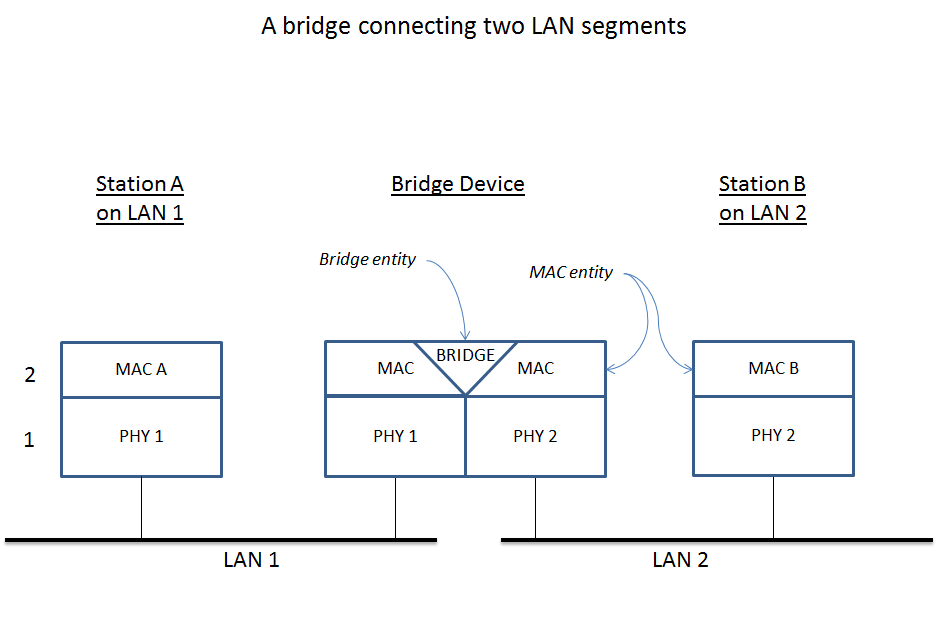Network bridging is the action taken by network equipment to create an aggregate network from either two or more communication networks, or two or more network segments. If one or more segments of the bridged network are wireless, it is known as wireless bridging. Bridging is distinct from routing, which allows multiple different networks to communicate independently while remaining separate.
A network bridge is a network device that connects multiple network segments. In the OSI model, bridging is performed in the first two layers, below the network layer.
There are four types of network bridging technologies: simple bridging, multiport bridging, learning or transparent bridging, and source route bridging.
Transparent bridging
A transparent bridge uses a forwarding database to send frames across network segments. The forwarding database is initially empty and entries in the database are built as the bridge receives frames. If an address entry is not found in the forwarding database, the frame is flooded to all other ports of the bridge, flooding the frame to all segments except the one from which it was received. By means of these flooded frames, the destination network will respond and a forwarding database entry will be created.
In the context of a two-port bridge, the forwarding database can be thought of as a filtering database. A bridge reads a frame's destination address and decides to either forward or filter. If the bridge determines that the destination node is on another segment on the network, it forwards (retransmits) the frame to that segment. If the destination address belongs to the same segment as the source address, the bridge filters (discards) the frame. As nodes transmit data through the bridge, the bridge establishes a filtering database of known MAC addresses and their locations on the network. The bridge uses its filtering database to determine whether a packet should be forwarded or filtered.
Transparent bridging is also applied to devices with more than two ports. As an example, consider three hosts, A, B and C and a bridge. The bridge has three ports. A is connected to bridge port 1, B is connected bridge port 2, C is connected to bridge port 3. A sends a frame addressed to B to the bridge. The bridge examines the source address of the frame and creates an address and port number entry for A in its forwarding table. The bridge examines the destination address of the frame and does not find it in its forwarding table so it floods it to all other ports: 2 and 3. The frame is received by hosts B and C. Host C examines the destination address and ignores the frame. Host B recognizes a destination address match and generates a response to A. On the return path, the bridge adds an address and port number entry for B to its forwarding table. The bridge already has A's address in its forwarding table so it forwards the response only to port 1. Host C or any other hosts on port 3 are not burdened with the response. Two-way communication is now possible between A and B without any further flooding.
Both source and destination addresses are used in this algorithm: source addresses are recorded in entries in the table, while destination addresses are looked up in the table and matched to the proper segment to send the frame to.
The technology was originally developed by the Digital Equipment Corporation (DEC) in the 1980s.
Simple bridging
A simple bridge connects two network segments, typically by operating transparently and deciding on a packet-by-packet basis whether or not to forward from one network to the other. A store and forward technique is typically used so, during forwarding, the packet integrity is verified on the source network and CSMA/CD delays are accommodated on the destination network. Contrary to simple repeaters that were used to just extend the maximum span of a segment, a bridge also reduces collisions by partitioning the collision domain. Additionally, a bridge lowers the overall amount of traffic by forwarding only those packets that are required to cross the bridge.
Multiport bridging
A multiport bridge connects multiple networks and operates transparently to decide on a packet-by-packet basis whether and where to forward traffic. Like the simple bridge, a multiport bridge typically uses store and forward operation. The multiport bridge function serves as the basis for network switches.

